► We drive the sizzling new Ford Focus RS
► Oversteering madness from the Blue Oval
► Read our full review in CAR+
Just try to get the new Focus RS to understeer on the road, I dare you. Even on track you have to take enormous liberties with your entry speed – for the most part the Focus just sucks it up, to the extent you only know how close you are to the limit by how hard you’re braced against the Recaro’s side bolsters and the grumbling noises coming from the front end as the systems fight to keep you on line. It just grips and grips and grips, at least until you decide to mix it up with the throttle.
Systems, grip and throttle – three words to define a new blue-collar hero. For there’s little point in beating around the bush here: the amount of car you get for the £29,995 it now takes to walk away from the dealership with a set of Focus RS keys is basically bonkers. The Audi RS3 and Mercedes-AMG might be faster and they might be fancier, but they cost a clear ten grand more for the same fundamental hardware package: five doors, four-wheel drive and a humungous amount of boost. When you also realise just how madly sophisticated the Ford’s four-wheel drive really is – and that’s not just by comparison, but full stop – the term ‘hero’ seems sincerely appropriate.
Under the bonnet, behind that gaping maw of a grille and those sabre-tooth bumper strakes is the engine from a bona fide muscle car. No, better than that – it’s an improved version of the engine from a bona fide muscle car. Okay, so it’s got only four cylinders, but this 2.3-litre turbo began life powering the 306bhp Ecoboost Mustang; now, having had its turbocharger, bore-liners and head (machined by Cosworth, no less) upgraded and paired with a revised intake system and high-flow exhaust, it produces an even healthier 345bhp at 6000rpm.
Jammed into a family hatchback, fettled forced induction firing those rotations, it goes like the absolute clappers and sounds as if it’s desperately late for the start of a rally stage. An ‘injection strategy’ in all but the default Normal driving mode means the RS leaves an anti-lag aping artillery barrage in its wake, adding immature joy to every heel-and-toe downshift – a delight that the choice of a (cheaper, lighter…) six-speed manual gearbox leaves entirely to you. Typically, Ford has the pedal spacing and weighting just right, and though it isn’t especially short-throw, the ’box has a mechanical action like oiled velvet, encouraging you to race home the changes.
While on-paper acceleration lags a little way behind the more powerful, auto-optimised A45 and RS3, once up and running the chunky Ford doesn’t feel like it’s giving much away at all. And nor does it keep you waiting for the big bang, with an almost silken quality to the way it lunges towards the upper reaches of the tacho. It’s nothing at all like the occasionally truculent Focus ST, although Ford’s sneaky use of speaker-driven sound-enhancement flatters the four-pot’s natural voice in the cabin, just as the genuine pops and literal bangs from the pair of potato cannons poking through the rear diffuser leave innocent bystanders shocked and (possibly) awed.
Nominally, peak torque is 324lb ft between 2000-4500rpm, but if you nail it hard enough this overboosts to 347lb ft – not only over the same rev duration but for up to 18 seconds as you rip through those gears. Hilariously, you only need to briefly lift and bring the hammer down again to get another 18sec of maximum thrust, and so on. Seems Ford took the decision to protect the engine, then decided to give you the chance to try to break it anyway. How often did the engineers use full throttle in testing? ‘Most of my guys drive digitally,’ says vehicle engineering manager Tyrone Johnson, with a laugh. Hit that sucker like a light switch.
And the thing is, you can. It’s not the first time Ford has sold a Focus RS with 345bhp, but there’s a big difference between the RS500 limited edition that invigorated the preceding model and this one: where the RS500 turned its front meats into the tyre equivalent of Roy Batty from Blade Runner (‘The light that burns twice as bright, burns half as long…’), complete with the corrupted steering and thuggish handling that suggests, believe the hype and the new Focus RS is more likely to barbecue its rears.
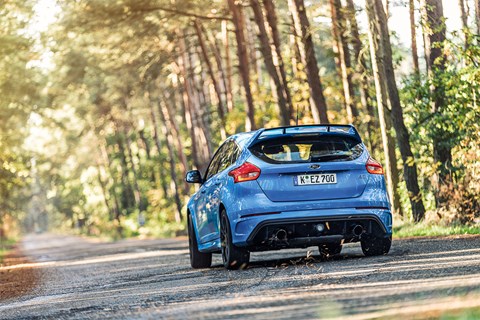
For although the Mk3 has traded the limitations of front-wheel drive for the traction-enhanced hopes and dreams of four-wheel drive – which does indeed allow you to get the power down far, far more ambitiously – this ain’t no simple Haldex front-rear shuffle. After 24 months of development, the new Focus RS has landed with a torque-vectoring back axle death-tuned out of the GKN system previously seen lumbering around in the Range Rover Evoque. To say that this solution, with its clutch packs and Ford-finessed software algorithms, seems pleased to be released from such confinement is a considerable understatement.
Does the new Focus RS go sideways? A better question is, when doesn’t it go sideways? Because honestly, I’m struggling to think of another car I’ve driven recently that brings its back end into play under a greater range of circumstances. Yes, it was being driven hard, and yes, the rubbered-in surface was greasy in places following the first rain in several days, but the extent to which this Focus begs you to adjust your cornering attitude with the throttle is just extraordinary. From lift-off oversteer on turn-in to proper power oversteer on corner exit, the new RS is ready and willing to deliver – and this is in the Sport driving mode, the second of the two modes Ford says are suitable for use on the road. In corporate, fingers-in-the-ears-don’t-want-to-know land, the remaining Track and Drift settings are intended for circuit use.
But the really extraordinary aspect of this is not that the RS is so ready and willing – the torque-vectoring rear axle sees to that, compared to the Normal driving mode, Sport cunningly holds torque at the outside rear wheel for longer – it’s that it makes you, the driver, feel so able. It does not jink about in the unpredictable manner of a revved-up spinning top, bouncing between skirting boards, but telegraphs its intentions with utter transparency, placing you in the best possible position to understand and react, and then in short order, to exploit. It is at once completely wild and astonishingly benign, the exact amount of corrective lock coming naturally, your understanding of weight transfer and power distribution super-enhanced – though no doubt aided by the subtle influence of the stability control system, which is tolerant of a surprising degree of misbehaviour even before you activate its second, more lenient setting. How Ford has achieved this intuitive feeling with such a complex electronics array boggles the mind; it involved months of software engineers sitting alongside traditional driving dynamics specialists, tweaking code in virtually real time. They must all have cast-iron constitutions.
The upshot of their effort is that when you do finally pluck up the courage to prod the drive-mode selector until Drift appears on the instrument cluster display, you feel relatively confident that the RS isn’t about to try to catch you out – despite Johnson’s warning that it’s no magic pill and it can get you into ‘a lot of trouble’. By default, Drift Mode retains some ESP intervention, but given the space you’ve got to switch it all the way off, if not for the novelty of producing gigantic rooster tails of smoke then to experience the full extent of what Ford has conceived.
It works by instructing the drivetrain to direct most of its attention to the outside rear wheel – the benefit of those GKN clutch packs – then once you’re sliding, levelling the torque distribution between the rear wheels in order to keep the drift ‘smooth’. In reality, you apply your right foot and almost instantly there’s a fizzing sensation from behind as the tyres begin to vaporise, and the back end swings out in the opposite direction to the way you’re turning with a kind of heavy metal balletic grace. Counter-steer, balance the throttle inputs and you can keep the rear wheels spinning in an arc until you run out of room. Or rubber. Fail to counter-steer, and at low speeds the Focus will calmly pirouette into the tightest donuts you have ever seen, and happily keep on rotating until you call time by lifting off or, as in my case (ahem), the rear drive unit overheats; fail to counter-steer at higher speeds and you will crash. Fortunately, as with everything else, the RS makes judging this easy.
If the word ‘Why?’ is currently flashing in your forebrain like a big neon sign, Ford’s answer is essentially ‘because we can.’ The RS four-wheel-drive system has abilities that no rival can currently match, and this is a magnificently indulgent demonstration of its prowess. If it all seems a bit Ken Block the Show Pony, that’s because you’re right – it’s not about getting the car down the road or around a circuit in the quickest time possible, it’s about making it involving. So if you’ve ever complained that a modern car has been too competent to be fun you’ve only got yourself to blame; the RS at least gives you options. And amongst these is the Track driving mode, which balances torque front and rear in order to simply go faster. Which it does, helped by a 40% firmer damper setting that quite possibly will rattle the teeth out of your skull on anything but the smoothest surfaces, and might just be the reason this mode isn’t recommended for the road. You can in fact activate the stiffer damping level at any time via a dedicated button at once bizarrely but usefully placed on the end of the indicator stalk; the additional body control does quell some of the car’s friskier tendencies, under threat of squaring-off your posterior like the steering wheel.
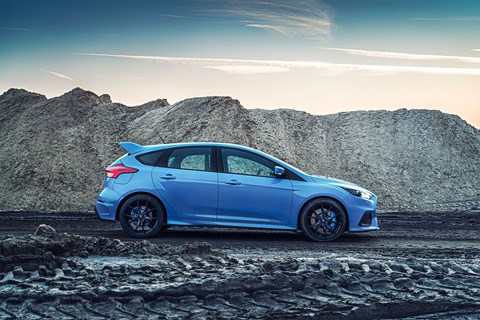
The bigger question is whether the degree of artifice at work gives as much satisfaction as driving the doors off a less sentient machine. There’s no doubt that the Focus RS majors in anticipating your needs – activate the launch control and it doesn’t just optimise traction but increases the torque available in first gear and primes the dual-mode dampers to help catapult you away from the traffic lights (just don’t forget you’re responsible for changing gear…). Yet you never quite escape the nagging sensation that the ultimate arbiter here is a hive mind of ECUs and sensors, rather than the squishy bundle of biology in the driver’s seat.
But I’m minded not to care. Much as I’m not fussed about the plain functionality of the interior – because Ford hones the touch points so well – I actually don’t think I’m bothered by how the new RS does what it does, I’m just stunned at the way it makes such a dynamic style of driving so accessible. It’s like all your supermarket shopping trolley fantasies made real, with the added bonus of being able to press a button, tell the four-wheel drive to stop messing about and blast off into the distance.
Serious competition
Audi RS3 Sportback
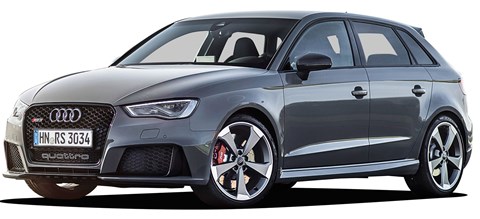
With an optional 174mph top speed and an exotic 362bhp five-cylinder motor that sounds like it’s got its own brass section, this quattro rocket certainly makes an impact – but then, it is still a bit of a blunt instrument. And it’s amazing how many optional extras seem essential given it costs a simply stratospheric £40,795.
Mercedes AMG A45
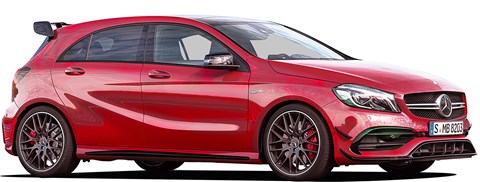
The spark that ignited the all-wheel-drive ultra-hatch war. Recently upgraded to a staggering 376bhp and now available with a front LSD, it retains its reputation as the Soyez FG of the family five-door world, taking just 4.2sec 0-62mph (0.1sec faster than the Audi). Can’t match the Focus RS for dynamics, though, and like the Audi leaves a £40k wallet hole.
RS under the skin
1) Steering
Quick-rack linear ratio EPAS with Normal and Sport weightings.
2) Tough
New bracing for body and chassis makes RS up to 200% stiffer in key areas.
3) Aero
It might not look as much of a thug as its predecessors but the new body kit, diffuser and rear spoiler deliver ‘zero lift’ at speed.
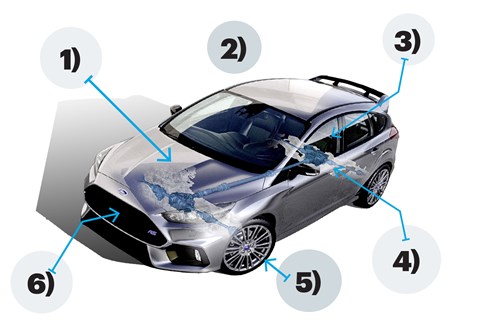
4) Chassis
GKN rear drive unit with twin clutch packs allow 100% of rear torque to be sent to a single wheel. Stiffer springs all round combine with ‘dual mode’ dampers to offer hardcore track capability and daily drive comfort.
5) Front
New knuckles, more negative camber and the same ‘torque vectoring by brake’ tech as the Fiesta ST. Those brakes are 350mm Brembos…
6) Engine
Huge grille opening feeds uprated 2.3 with twin-scroll Honeywell turbo and Cosworth head.
The specs: Ford Focus RS
Price: £29,995
Engine: 2261cc turbo 4-cyl, 345bhp @ 6000rpm, 324lb ft @ 2000-4500rpm (347lb ft on overboost)
Transmission: Six-speed manual, all-wheel drive with torque vectoring rear axle
Suspension: MacPherson strut with semi-isolated subframe, front; SLA independent rear axle with control blade, rear; dual-mode dampers
Performance: 4.7sec 0-62mph, 165mph, 36.7mpg, 175g/km CO2
Length/width/height: 4390/ 1823/1472mm
Weight/made from: 1599kg/steel
On Sale: Order now, first deliveries Spring 2016